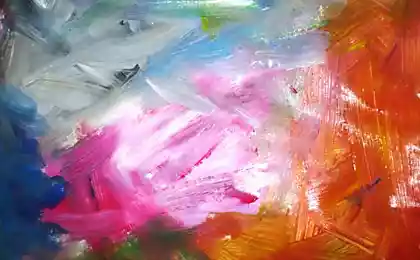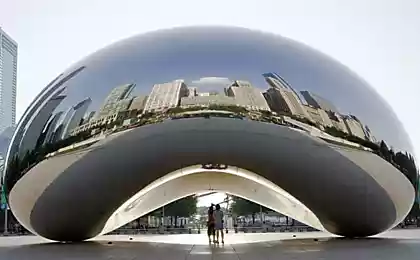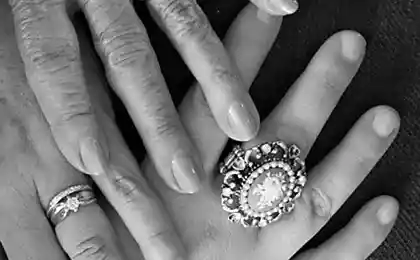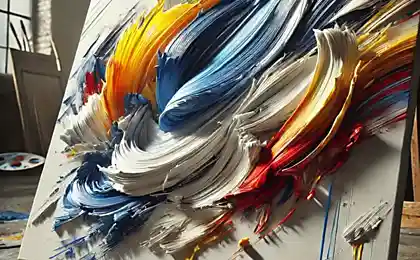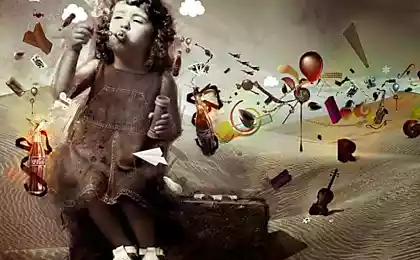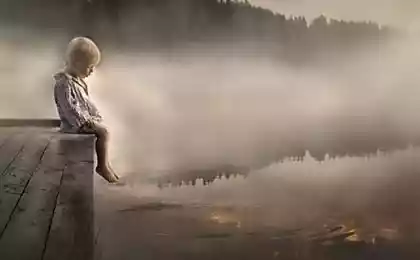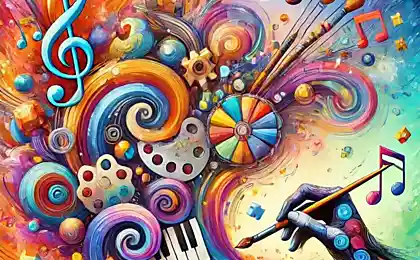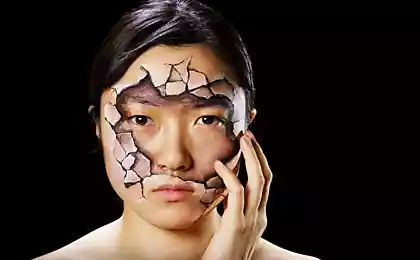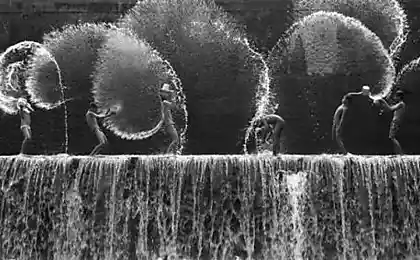549
20 ideas extraordinary paint for your kids
If your child periodically gets upset, saying, "I don't know how to draw" or "not pretty", leave attempts to draw the sample, as is done in the various circles of drawing, and try spontaneous drawing technique, not a standard.
We offer you 20 variations of such techniques that reveal the individuality of the child.
Passepartout.
This is when a Doodle of a child is inserted into the sheet-cut to any shape. Ie cut out the template, for example, butterfly and placed on top of cercania" baby. In the end, the work of the child forms a unique pattern of a butterfly's wings.
Drawing feet.
Secure to floor with tape a sheet of paper. Put the baby between his feet a pencil and ask them to draw something. You can do both feet at the same time on a single sheet of paper. Attach to the wall a large sheet of paper and ask your child to draw something on it, lying on his back.

Frottage.
A sheet of paper is located on the flat raised the subject and then moving not sharpened colored pencil on the surface, you get the impression that mimic the main texture. You can pencil little just to grind relief surface. Who tried to draw on the table with relnum coating knows how this drawing technique may be included in the drawing completely uninvited. And you can create drawings by combining several terrain objects.
Air paint.
To prepare the paint mix in a small Cup:
To apply paint to have a thick piece of cardboard (if you don't have brushes, you can use a cotton swab).
Attention! The cardboard should not contain synthetic materials and films, use regular cardboard or very heavy paper.
Place the picture in the microwave, using high mode for 10 — 30 seconds until the paint become dry. The drying time depends on the thickness of the layer of paint and its consistency.
Marble paper.
Need: cream (foam) for shaving, watercolor paint or food coloring, a flat plate for mixing shaving foam and paint, paper, scraper.
Work plan:
Evenly apply a thick layer of shaving foam on a plate. Mix the paint or food coloring of different colors with a small amount of water to make a saturated solution. With a brush or pipette, drip the paint of different colors on the surface of the foam in random order. Now all with the same brush or stick nicely spread paint over the surface to form fanciful zig-ZAGS, wavy lines, etc. This is the most creative phase of the whole work, which will satisfy the children. Now take a sheet of paper and carefully apply it to the surface of the resulting patterned foam. Put the sheet on the table. You only have to scrape off all the foam with a sheet of paper. For these purposes, you can use a piece of cardboard or cut in half cover. Under a layer of shaving foam you will find stunning marble patterns. The paint had to quickly soak into the paper, you only need to let it dry for a few hours. Painting with cling film.
Apply spots of several colors of watercolor or gouache paint to the entire surface of the sheet. Imposed on top of the tape and draw while pressing the film, a variety of lines. Allow the paint to dry and remove the tape. Bring drawing to the end, markers or pencils.
Soap painting.
Paint you can mix with soap and then apply brush patterns and shapes. When drawing soap bubbles are formed that create the texture of the paint strokes.
Lexography.
Let your child drop the paint onto the leaf and tilt it in different directions, and then add the BLOB to get any image. Or the child dips the brush in paint, then puts a blot on a sheet of paper and fold the sheet in half so that the "BLOB" is imprinted on the second half of the sheet. Then unrolls the sheet and tries to figure out who or what is it like in the picture.
Drawing on a wet surface.
The technique is very simple: dampen the paper with water, let dry 30 seconds and begin to paint with watercolors. Paint is spread out in different directions and get very interesting stains (dawn, clouds, trees, rainbow).
Salt.
Pre-make on paper sketch. Wet it with water using a brush, sprinkle with salt, wait for it to absorb water, the excess salt bulk. When all dry, draw the missing elements and paint. Salt well to draw dragonflies, birds, jellyfish, butterflies, snow, smoke.
Wax.
Prepare a sheet with silhouettes of animals, you advance to "draw" a candle. Painting drawing paint, a child suddenly "create" images of animals.
The foam or sponge.
Dip the sponge in the thick gouache paint, a child could draw landscapes, bouquets of flowers, branches of lilacs, Apple trees.
A bundle of pencils.
Securely tape a large sheet of paper. Bundle of colored pencils so that the sharpened ends are on the same level. Invite a child to draw.
Chalk and starch.
Pour on a sheet of paper and a little starch with your hands evenly spread on the surface. Invite the child to draw with crayons on slippery surfaces. It is better to use the basic colors of crayons that they give you a new color.
Colored glue.
Pour the glue on the empty bottles, add to each a few drops of different colors, and you're ready to create works of art. Draw a colored glue on dark paper, using the "drip" technique.
Gauze swab.
Invite a child to dip a gauze swab into the paint and to draw clouds, bubbles, snow drifts, ducks, butterflies. Missing details necessary to finish with a brush or marker.
Corn on the cob.
Think of any image. Dip the cob into paint and roll on a clean sheet of paper. Make the imprint of the "tail" of a corn cob.
Prints.
Do pictures prints stamps.
Drawing points.
Little light pressure on the pencil outlines of the preliminary contour of the object, then point technique fills the space inside of it using pens or pencils of different colors.
Painting with spray.
The most basic here – to master the technique of "spraying". On a dry toothbrush with fairly stiff bristles apply the gouache, a little less than you usually put toothpaste. Texture paint – slightly thicker than paste, so the water is usually not needed. Hold the brush in your left hand, bristles down at a distance of 3-4 cm from the paper and stick scrape the bristles toward you.
Very beautiful mixed colors "sprayed" (salute) and yellow-red (Golden autumn) on a white sheet; the white "sprayed" on a dark blue background (winter landscape).
Magic beads.
Material: cover from the box, marbles, paint, paper, brushes, water.
The progress of the work. In the box to put the sheet of paper on it, apply a few drops of colored or monochromatic paint. Box 2-3 ball and shake the box so that the marbles rolled around, mixing paint, creating a pattern.published
P. S. And remember, only by changing their consumption — together we change the world! ©
Join us in Facebook , Vkontakte, Odnoklassniki
Source: vk.com/club55421059?w=wall-55421059_6343
We offer you 20 variations of such techniques that reveal the individuality of the child.
Passepartout.
This is when a Doodle of a child is inserted into the sheet-cut to any shape. Ie cut out the template, for example, butterfly and placed on top of cercania" baby. In the end, the work of the child forms a unique pattern of a butterfly's wings.
Drawing feet.
Secure to floor with tape a sheet of paper. Put the baby between his feet a pencil and ask them to draw something. You can do both feet at the same time on a single sheet of paper. Attach to the wall a large sheet of paper and ask your child to draw something on it, lying on his back.

Frottage.
A sheet of paper is located on the flat raised the subject and then moving not sharpened colored pencil on the surface, you get the impression that mimic the main texture. You can pencil little just to grind relief surface. Who tried to draw on the table with relnum coating knows how this drawing technique may be included in the drawing completely uninvited. And you can create drawings by combining several terrain objects.
Air paint.
To prepare the paint mix in a small Cup:
- one tablespoon of "self-raising" (pancake) flour is flour with baking powder already added. You can simply add in the flour (500 g) 1H.l. soda and 1H.l. citric acid,
- a few drops of food coloring,
- one tablespoon of salt.
To apply paint to have a thick piece of cardboard (if you don't have brushes, you can use a cotton swab).
Attention! The cardboard should not contain synthetic materials and films, use regular cardboard or very heavy paper.
Place the picture in the microwave, using high mode for 10 — 30 seconds until the paint become dry. The drying time depends on the thickness of the layer of paint and its consistency.
Marble paper.
Need: cream (foam) for shaving, watercolor paint or food coloring, a flat plate for mixing shaving foam and paint, paper, scraper.
Work plan:
Evenly apply a thick layer of shaving foam on a plate. Mix the paint or food coloring of different colors with a small amount of water to make a saturated solution. With a brush or pipette, drip the paint of different colors on the surface of the foam in random order. Now all with the same brush or stick nicely spread paint over the surface to form fanciful zig-ZAGS, wavy lines, etc. This is the most creative phase of the whole work, which will satisfy the children. Now take a sheet of paper and carefully apply it to the surface of the resulting patterned foam. Put the sheet on the table. You only have to scrape off all the foam with a sheet of paper. For these purposes, you can use a piece of cardboard or cut in half cover. Under a layer of shaving foam you will find stunning marble patterns. The paint had to quickly soak into the paper, you only need to let it dry for a few hours. Painting with cling film.
Apply spots of several colors of watercolor or gouache paint to the entire surface of the sheet. Imposed on top of the tape and draw while pressing the film, a variety of lines. Allow the paint to dry and remove the tape. Bring drawing to the end, markers or pencils.
Soap painting.
Paint you can mix with soap and then apply brush patterns and shapes. When drawing soap bubbles are formed that create the texture of the paint strokes.
Lexography.
Let your child drop the paint onto the leaf and tilt it in different directions, and then add the BLOB to get any image. Or the child dips the brush in paint, then puts a blot on a sheet of paper and fold the sheet in half so that the "BLOB" is imprinted on the second half of the sheet. Then unrolls the sheet and tries to figure out who or what is it like in the picture.
Drawing on a wet surface.
The technique is very simple: dampen the paper with water, let dry 30 seconds and begin to paint with watercolors. Paint is spread out in different directions and get very interesting stains (dawn, clouds, trees, rainbow).
Salt.
Pre-make on paper sketch. Wet it with water using a brush, sprinkle with salt, wait for it to absorb water, the excess salt bulk. When all dry, draw the missing elements and paint. Salt well to draw dragonflies, birds, jellyfish, butterflies, snow, smoke.
Wax.
Prepare a sheet with silhouettes of animals, you advance to "draw" a candle. Painting drawing paint, a child suddenly "create" images of animals.
The foam or sponge.
Dip the sponge in the thick gouache paint, a child could draw landscapes, bouquets of flowers, branches of lilacs, Apple trees.
A bundle of pencils.
Securely tape a large sheet of paper. Bundle of colored pencils so that the sharpened ends are on the same level. Invite a child to draw.
Chalk and starch.
Pour on a sheet of paper and a little starch with your hands evenly spread on the surface. Invite the child to draw with crayons on slippery surfaces. It is better to use the basic colors of crayons that they give you a new color.
Colored glue.
Pour the glue on the empty bottles, add to each a few drops of different colors, and you're ready to create works of art. Draw a colored glue on dark paper, using the "drip" technique.
Gauze swab.
Invite a child to dip a gauze swab into the paint and to draw clouds, bubbles, snow drifts, ducks, butterflies. Missing details necessary to finish with a brush or marker.
Corn on the cob.
Think of any image. Dip the cob into paint and roll on a clean sheet of paper. Make the imprint of the "tail" of a corn cob.
Prints.
Do pictures prints stamps.
Drawing points.
Little light pressure on the pencil outlines of the preliminary contour of the object, then point technique fills the space inside of it using pens or pencils of different colors.
Painting with spray.
The most basic here – to master the technique of "spraying". On a dry toothbrush with fairly stiff bristles apply the gouache, a little less than you usually put toothpaste. Texture paint – slightly thicker than paste, so the water is usually not needed. Hold the brush in your left hand, bristles down at a distance of 3-4 cm from the paper and stick scrape the bristles toward you.
Very beautiful mixed colors "sprayed" (salute) and yellow-red (Golden autumn) on a white sheet; the white "sprayed" on a dark blue background (winter landscape).
Magic beads.
Material: cover from the box, marbles, paint, paper, brushes, water.
The progress of the work. In the box to put the sheet of paper on it, apply a few drops of colored or monochromatic paint. Box 2-3 ball and shake the box so that the marbles rolled around, mixing paint, creating a pattern.published
P. S. And remember, only by changing their consumption — together we change the world! ©
Join us in Facebook , Vkontakte, Odnoklassniki
Source: vk.com/club55421059?w=wall-55421059_6343
To love ourselves: practice with a mirror and 9 councils of Louise hay
Interior design: details decide everything!


